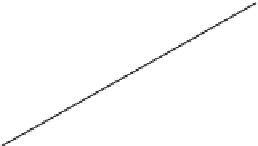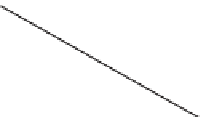Graphics Reference
In-Depth Information
you can easily convert between them. If we have two lines whose intersection
we need to compute, we could do an implicit-implicit, parametric-parametric, or
parametric-implicit computation. The implicit-implicit version is messy enough
that it's better to convert one line to parametric form and use the implicit-
parametric intersection approach. We'll begin by computing the intersection of
two lines in parametric form, mostly so that you see the benefit of the later
implicit-parametric form. In general, we find that intersections between implicit
and parametric forms tend to produce the simplest algebra.
Suppose we have two lines in parametric form, that is, two functions
R
2
:
t
γ
:
R
→
→
tA
+(
1
−
t
)
B
,
(7.72)
h
(1)
D
R
2
:
s
η
:
R
→
→
sC
+(
1
−
s
)
D
,
(7.73)
A
whose images are (respectively) the line
AB
and the line
CD
(see Figure 7.13).
We'd like to find the point
P
where these lines intersect. That point will lie on the
line determined by
g
(0)
P
h
(0)
γ
, that is, it will be
γ
(
t
0
)
for some real number
t
0
; similarly,
B
C
it'll be
η
(
s
0
)
for some real number
s
0
. Equating these gives
g
(1)
Figure 7.13: The lines AB and
CD are the images of the para-
metric functions
γ
and
η
;they
intersect at the unknown point P.
t
0
A
+(
1
−
t
0
)
B
=
s
0
C
+(
1
−
s
0
)
D
,
(7.74)
which can also be written
B
−
D
=
−
t
0
(
A
−
B
)+
s
0
(
C
−
D
)
,
(7.75)
which is a nice form because it involves only vectors (i.e., differences between
points).
If we write out Equation 7.74 in terms of the known coordinates of the points
A
,
B
,
C
, and
D
, we get two equations in the two unknowns
s
0
and
t
0
and can
solve for them. We can then compute
P
by computing either
t
0
A
+(
1
−
t
0
)
Bor
s
0
C
+(
1
s
0
)
D
.
An alternative, and preferable, approach is to use the vector form shown in
Equation 7.75. Letting
v
=
A
−
−
B
and
u
=
C
−
D
,wehave
B
−
D
=
−
t
0
v
+
s
0
u
.
(7.76)
Taking the dot product of both sides with
×
v
, we get
(
B
−
D
)
·
(
×
v
)=
−
t
0
v
·
(
×
v
)+
s
0
u
·
(
×
v
)
(7.77)
(
B
−
D
)
·
(
×
v
)=
s
0
u
·
(
×
v
)
(7.78)
(
B
−
D
)
·
(
×
v
)
=
s
0
(7.79)
u
·
(
×
v
)
where the simplification arises because
v
is perpendicular to
v
, so their dot prod-
uct is zero. The last trick—eliminating a term from an equation by taking the dot
product of both sides with a vector orthogonal to that term—is often useful.
×








